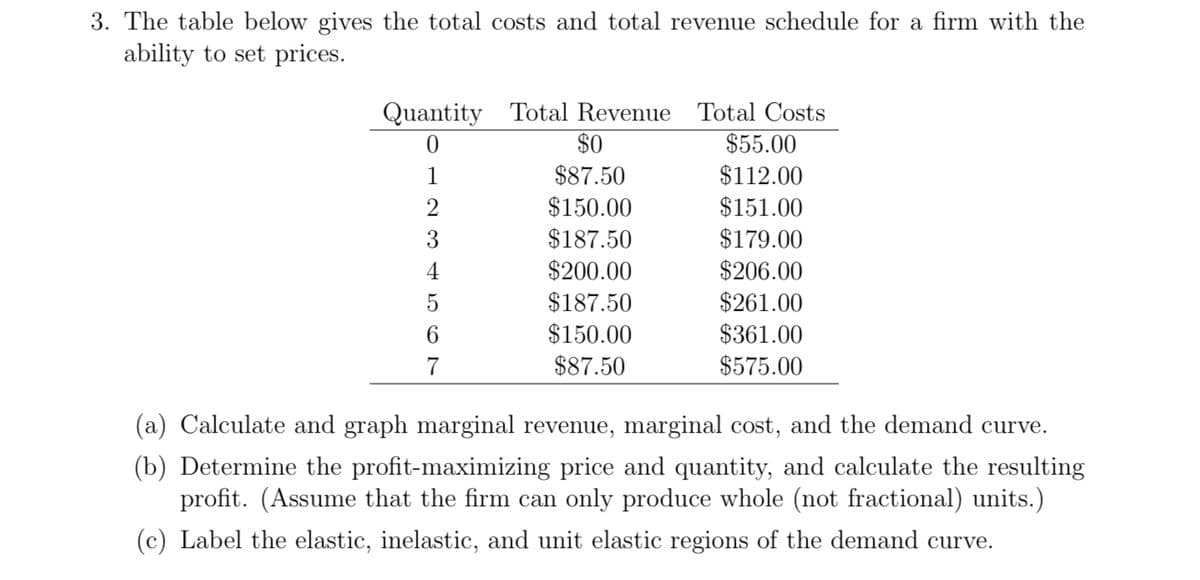3. The table below gives the total costs and total revenue schedule for a firm with the ability to set prices. Quantity Total Revenue Total Costs 0 $0 $55.00 1 $87.50 $112.00 2 $150.00 $151.00 3 $187.50 $179.00 4 $200.00 $206.00 5 $187.50 $261.00 6 $150.00 $361.00 7 $87.50 $575.00 (a) Calculate and graph marginal revenue, marginal cost, and the demand curve. (b) Determine the profit-maximizing price and quantity, and calculate the resulting profit. (Assume that the firm can only produce whole (not fractional) units.) (c) Label the elastic, inelastic, and unit elastic regions of the demand curve.
3. The table below gives the total costs and total revenue schedule for a firm with the ability to set prices. Quantity Total Revenue Total Costs 0 $0 $55.00 1 $87.50 $112.00 2 $150.00 $151.00 3 $187.50 $179.00 4 $200.00 $206.00 5 $187.50 $261.00 6 $150.00 $361.00 7 $87.50 $575.00 (a) Calculate and graph marginal revenue, marginal cost, and the demand curve. (b) Determine the profit-maximizing price and quantity, and calculate the resulting profit. (Assume that the firm can only produce whole (not fractional) units.) (c) Label the elastic, inelastic, and unit elastic regions of the demand curve.
Principles of Economics 2e
2nd Edition
ISBN:9781947172364
Author:Steven A. Greenlaw; David Shapiro
Publisher:Steven A. Greenlaw; David Shapiro
Chapter8: Perfect Competition
Section: Chapter Questions
Problem 39P: The AAA Aquarium Co. sells aquariums for 20 each. Fixed costs of production are 20. The total...
Related questions
Question

Transcribed Image Text:3. The table below gives the total costs and total revenue schedule for a firm with the
ability to set prices.
Quantity Total Revenue Total Costs
0
$0
$55.00
1
$87.50
$112.00
2
$150.00
$151.00
3
$187.50
$179.00
4
$200.00
$206.00
5
$187.50
$261.00
6
$150.00
$361.00
7
$87.50
$575.00
(a) Calculate and graph marginal revenue, marginal cost, and the demand curve.
(b) Determine the profit-maximizing price and quantity, and calculate the resulting
profit. (Assume that the firm can only produce whole (not fractional) units.)
(c) Label the elastic, inelastic, and unit elastic regions of the demand curve.
Expert Solution
This question has been solved!
Explore an expertly crafted, step-by-step solution for a thorough understanding of key concepts.
Step by step
Solved in 2 steps with 2 images

Recommended textbooks for you

Principles of Economics 2e
Economics
ISBN:
9781947172364
Author:
Steven A. Greenlaw; David Shapiro
Publisher:
OpenStax

Managerial Economics: A Problem Solving Approach
Economics
ISBN:
9781337106665
Author:
Luke M. Froeb, Brian T. McCann, Michael R. Ward, Mike Shor
Publisher:
Cengage Learning


Principles of Economics 2e
Economics
ISBN:
9781947172364
Author:
Steven A. Greenlaw; David Shapiro
Publisher:
OpenStax

Managerial Economics: A Problem Solving Approach
Economics
ISBN:
9781337106665
Author:
Luke M. Froeb, Brian T. McCann, Michael R. Ward, Mike Shor
Publisher:
Cengage Learning
